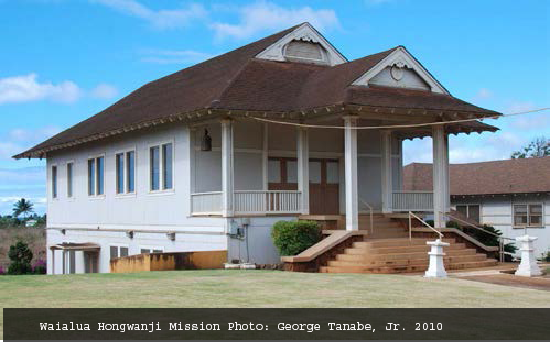By Boyd Ready
When the Waialua mill stack was suddenly demolished last November, everyone noticed. There was consternation and sadness. Without being used an old landmark structure or site will languish. It’s like what Gore Vidal once said about how you go bankrupt: slowly, then, suddenly. Well, the Waialua Hongwanji, located just west of the Waialua mill grounds, across from the old Fujioka store, is beginning to languish. So, let’s get up to speed on this magnificent old temple.
It is dedicated to Shinran, from the 12th century, in Japan. He founded the Jodo Shinshu, or True Pure Land School of Buddhist thought, and established temples called Hongwanji, or ‘Temples of the Original Vow.’ For some perspective, this founding was around the time of the Norman conquest of England, Ghengis Khan’s conquest of Asia, and the Tahiti-origin Polynesians who brought the ali’i and kapu social system to Hawaii.
Shinran and his teacher, Honen, developed Buddhist teachings that attracted large followings of the common people. The severe privations and discipline of monastic practice often failed to result in the attainment of true enlightenment. Honen emphasized the simple chanting of a mantra that would purify one morally and spiritually. Shinran simplified practices even further, proclaiming salvation from the karma of desire as attainable through Amida Buddha, whose grace, as Infinite Light and Life that saves, brings you to the pure land, not your exertions or privations.
So, with the influx of thousands of Japanese laborers as Waialua Agricultural Co. cleared land, built railroads, houses, a dam and a mill, our Waialua Hongwanji began. In 1902 Bishop Imamura built a priest’s residence and a school. A basin, carved from native stone, and a stand-alone belfry, are from 1912. As the congregation’s size and needs increased, the existing temple was built in 1932. A 4-foot-long photograph from the 1937 thirty-fifth anniversary depicts the celebration for a new statue of Amida Buddha. A magnificent transom depicting heavenly beings spans the entire interior space above the central shrine. Opulent shrines to Shinran, on the right, and Rennyo, on the left, exhibit the veneration due to Jodo Shinsu founders.
Waialua’s demography has changed. Only a handful of the congregation remain, and regular services have ceased. The last bon dance here, attracting locals as well as club dancers from all over Oahu, was a few years ago. But the necessary annual blessings for Waialua’s many cemeteries are still done, with Waialua Hongwanji’s leader, Donald Matsumoto, participating. The duty of families and priests to bless the ancestors and burn incense to their memory continues today with clear beautiful bells and pure congregational singing at our four Waialua cemeteries.
May the magnificent Waialua Hongwanji return to appropriate use or adaptive re-use that preserves its special significance for our history.
For more information about the Historical Society or to schedule a walking tour, contact Antya Miller at 808-342-8557 or email info@waialuahistoricalsociety. org



